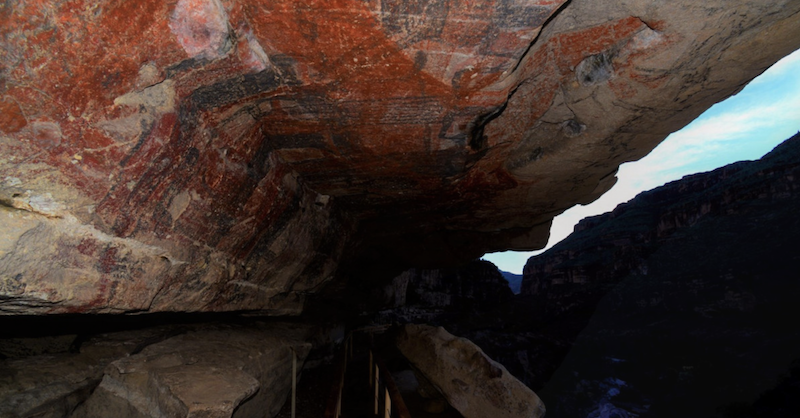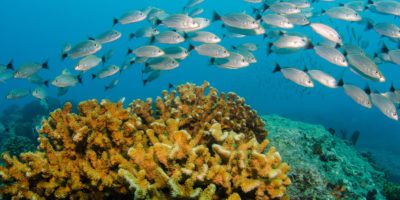
The Gulf of California, listed as a World Heritage site by UNESCO, boasts impressive biodiverse marine ecosystems. It is recognized as an area of global marine conservation, and scientists qualify it as a natural laboratory for the investigation of speciation.
This protected site comprises 688,558 hectares, 244 islands, islets, and coastal areas and contains 39% of the world’s total species of marine mammals and a third of the world’s marine cetacean species. No wonder whales are attracted to the warm, nutrient-dense waters of the Sea of Cortez every year to mate, give birth and nurse their calves.
“Almost all major oceanographic processes occurring in the planet’s oceans are present in the Gulf of California and protected islands, giving it extraordinary importance for study.”
—UNESCO
Being so privileged to receive the visit of whales every year from mid-December through mid-April, Los Cabos remains one of the finest places on the planet to spot these majestic cetaceans, and after having an enjoyable 2022-2023 whale season in Los Cabos, we have gathered interesting facts about 5 of the most common species spotted in the area.
Did you know?
The word Cetacean comes from the Latin cetus, meaning large sea creature. It refers to over 80 marine mammal species, including all whales, dolphins, and porpoises.
Humpback whales
These friendly and playful whales live in all oceans around the world. They travel great distances yearly, and their long migrations can take 5,000 miles from tropical breeding grounds to more productive feeding grounds. Humpback whales feed on krill and small fish and use their baleen plates (long, flat plates made of fingernail-like material called keratin) like a sieve to strain huge amounts of water.
The hump on their back gives their name to these whales, which are a favorite of whale watchers for their jumps out of the water. Their songs appear to be shared by all singing members in the same area of the ocean: as the song changes, all members sing the new song.
They use several techniques to help them corral and disorient prey, like sounds, the seafloor, and even their pectoral fins. One of the most fascinating techniques is called “group coordinated bubble net feeding,” which involves using curtains of air bubbles to condense prey.
Humpback whales reach sexual maturity between the ages of 4 and 10 years. Females produce a single calf every 2 to 3 years on average, although annual calving has been documented in some individuals. Calves are born after an 11-month gestation and measure about 13 to 16 feet in length, and stay near their mothers for up to 1 year before weaning.
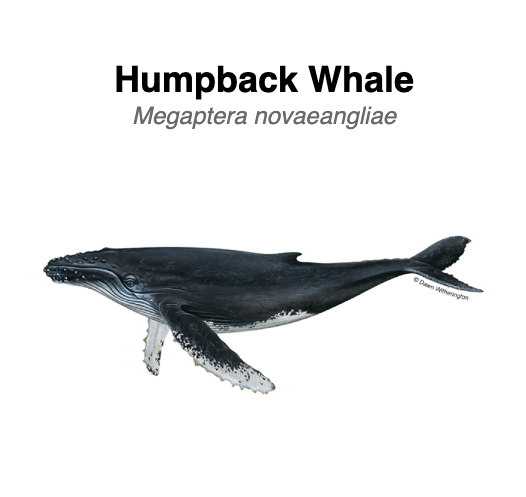
Quick facts
Weight: Up to about 40 tons
Length: Up to about 60 feet
Lifespan: About 80 to 90 years
Gray Whales
Once common throughout the Northern Hemisphere, gray whales are now only regularly found in the North Pacific Ocean. They make one of the longest annual migrations of any mammal, traveling about 10,000 miles round-trip and upwards of 14,000 miles in some cases.
Lacking a dorsal fin, they instead have a dorsal hump about two-thirds of the way back on the body, and a series of 6 to 12 small bumps, called “knuckles,” between the dorsal hump and the tail flukes. The tail flukes are nearly 10 feet wide with S-shaped trailing edges and a deep median notch.
Calves are typically born dark gray and lighten as they age to brownish-gray or light gray. All gray whales are mottled with lighter patches. They have barnacles and whale lice on their bodies, with higher concentrations found on the head and tail.
They are primarily bottom feeders that consume a wide range of benthic (sea floor) and epibenthic (above the sea floor) invertebrates, such as amphipods. Gray whales suck sediment and food from the sea floor by rolling on their sides and swimming slowly along, filtering their food through 130 to 180 coarse baleen plates on each side of their upper jaw. In doing so, they often leave long trails of mud behind them and “feeding pits” on the seafloor. Killer whales prey upon gray whales.
Gray whales become sexually mature between 6 and 12 years, with the average of maturity being about 8 to 9 years old. After 12 to 13 months of gestation, females give birth to a single calf. Newborn calves are approximately 14 to 16 feet long and weigh about 2,000 pounds.

Quick facts
Weight: About 45 tons
Length: 42 to 49 feet
Lifespan: Unknown, although one female was estimated at 75 to 80 years old after death.
Blue whales
Blue whales are the largest animals ever to live on our planet. They feed almost exclusively on krill, straining huge volumes of ocean water through their baleen plates (which hang from the roof of the mouth and work like a sieve). Some of the biggest individuals may eat up to 6 tons of krill a day.
They are found in all oceans except the Arctic Ocean. Their mottled blue-gray color appears light blue under water—hence their name, the blue whale. The mottling pattern is variable and can be used to identify individuals.
These whales typically swim at about 5 miles an hour while they are feeding and traveling but can accelerate to more than 20 miles an hour for short bursts. They are among the loudest animals on the planet, emitting a series of pulses, groans, and moans, that can be heard by other whales up to 1,000 miles away.
The primary diet of blue whales is krill—tiny shrimp-like animals, but fish and copepods (tiny crustaceans) may occasionally be part of the blue whale’s diet. When blue whales hunt for food, they filter feed by swimming toward large schools of krill with their mouth open and closing their mouths around the krill while inflating their throat pleats. Once closed, blue whales then push the trapped water out of their mouth with their tongue and use their baleen plates to keep the krill trapped inside.

Quick facts
Weight: Up to 165 tons
Length: Up to 110 feet
Lifespan: Estimated at around 80 to 90 years
Fin whales
The fin whale is the second-largest whale species on earth, second only to the blue whale. It is found throughout the world’s oceans. It gets its name from an easy-to-spot fin on its back, near its tail.
Fin whales have sleek, streamlined bodies with V-shaped heads and a tall, hooked dorsal fin, about two-thirds of the way back on the body. Many of these species have several light-gray, V-shaped “chevrons” behind their heads; and the underside of the tail flukes is white with a gray border. These markings are unique and can be used to identify Individual fin whales.
During the summer, fin whales eat up to 2 tons of food daily, comprising krill, small schooling fish (including herring, capelin, and sand lance), and squid by lunging into schools of prey with their mouth open, using their 50 to 100 accordion-like throat pleats to gulp large amounts of food and water. They then filter the food particles from the water, using the 260 to 480 baleen plates that they have in place of teeth on each side of the mouth.
Fin whales have long lives—they reach physical maturity at about 25 years. Males become sexually mature at 6 to 10 years of age and females at 7 to 12 years of age. After 11 to 12 months of gestation, a pregnant female gives birth to a single calf in tropical and subtropical areas during midwinter. Newborn calves are about 18 feet long, and weigh 4,000 to 6,000 pounds.
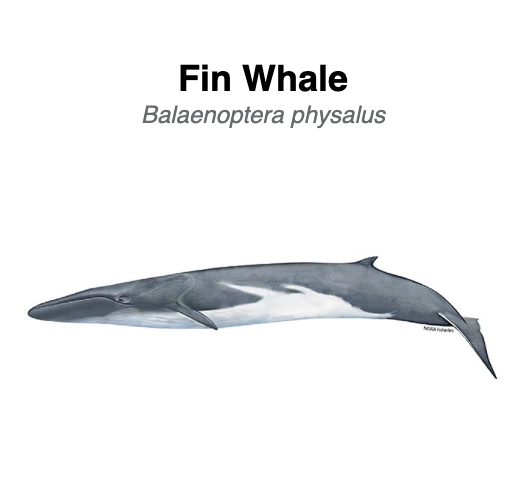
Quick facts
Weight: 40 to 80 tons
Length: 75 to 85 feet
Lifespan: 80 to 90 years
Bryde’s whale
Bryde’s (pronounced “broodus”) whales are members of the baleen whale family. They are considered one of the “great whales,” or rorquals, which is a group that also includes blue whales and humpback whales.
They are found in warm, temperate oceans, including the Atlantic, Indian, and Pacific. Some populations of Bryde’s whales make short migratory movements with the seasons, while others do not migrate, making them unique among other migrating baleen whales.
Their bodies are sleek and their flippers are slender and pointed, and have a strongly hooked dorsal fin located about two-thirds back on the body. These rorquals eat an estimated 1,320 to 1,450 pounds of food per day, and use their 40 to 70 throat grooves on their underside and 250 to 410 gray, coarse baleen plates on each side of their mouths to strain while they feed. Male Bryde’s whales are usually slightly smaller than females.
Bryde’s whales become sexually mature at around nine years of age and can mate year-round. The peak of the breeding and calving season occurs in autumn, and females give birth to a single calf every two to three years. Pregnancy lasts 10 to 12 months, and calves nurse for about 12 months. Their lifespan is unknown.
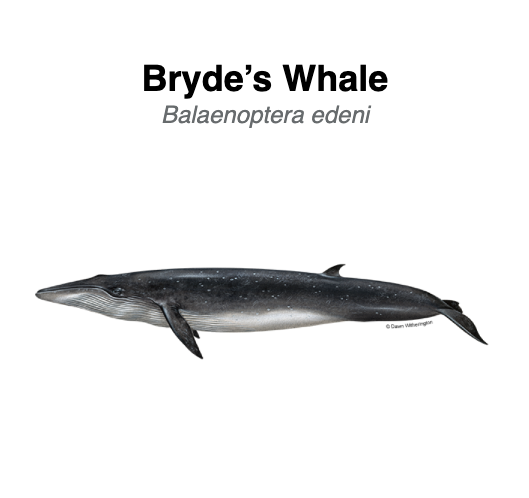
Quick facts
Weight: About 45 tons
Length: 40 to 55 feet
Lifespan: Unknown
Source and whale illustrations: National Oceanic and Atmospheric Administration
So long to these fantastic animals until their next visit!
In the meantime, we hope you have enjoyed the reading!


